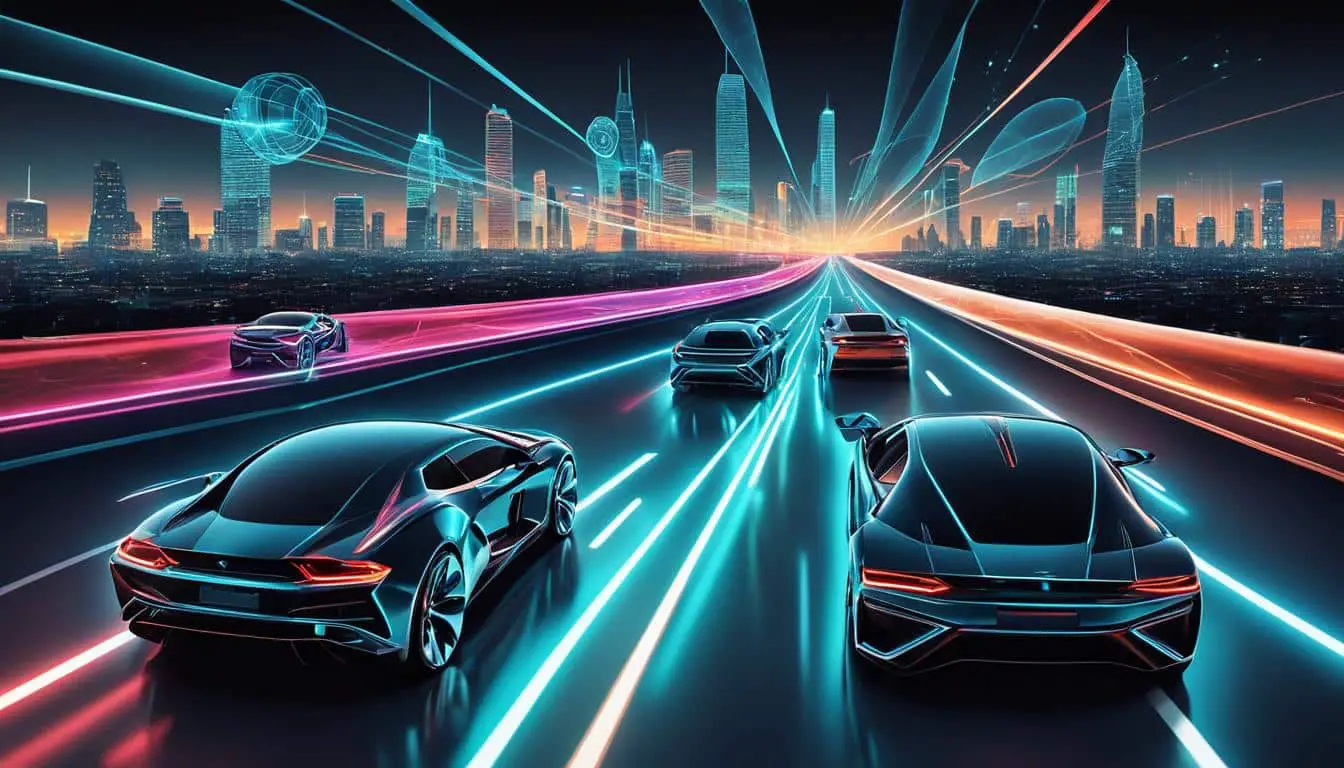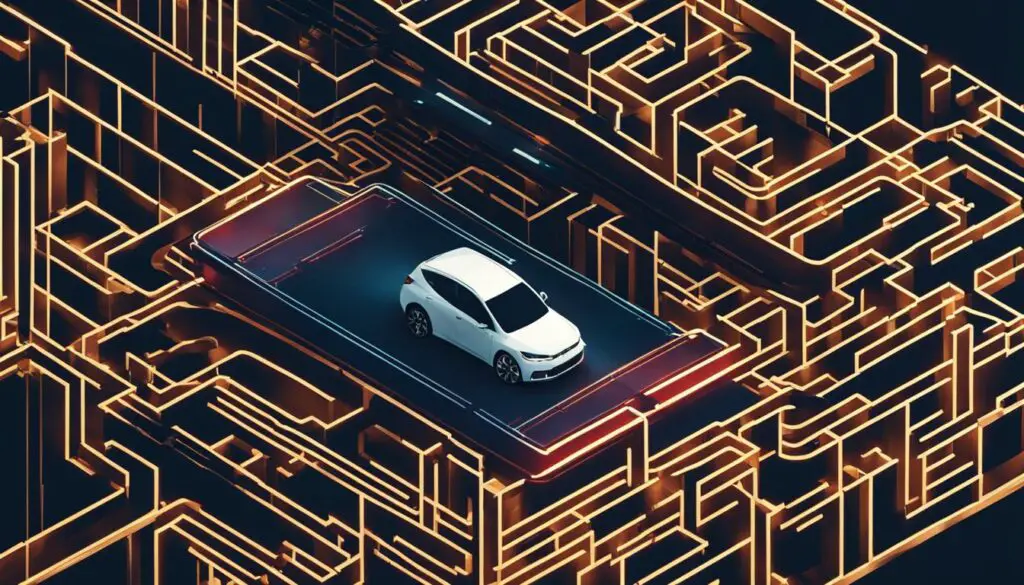
Vehicle-to-Vehicle Communication: Driving Towards a Connected Future
The advancement of technology continues to shape various aspects of our lives, including the way we travel and interact on the roads. One significant leap in this direction is the development of vehicle-to-vehicle (V2V) communication technologies. These innovative solutions enable vehicles to communicate with each other, opening up a world of possibilities for a safer and more connected driving experience.
Imagine a future where cars on the road can exchange real-time information such as speed, direction, and location. This seamless communication between vehicles can help prevent accidents, reduce traffic congestion, and improve overall road safety. With V2V communication, vehicles can essentially “talk” to one another, creating a network of smart cars that can anticipate potential hazards and react accordingly.
Key Takeaways:
- Vehicle-to-vehicle communication technologies enhance road safety and create a connected driving experience.
- Real-time information exchange between vehicles allows for proactive accident prevention and reduced traffic congestion.
- V2V communication enables enhanced situational awareness and improved efficiency in traffic management.
- The advancements in V2V technology include wireless communication and standardized protocols for interoperability.
- Real-world applications of V2V communication technologies include cooperative adaptive cruise control and intersection collision warning systems.
The Importance of Vehicle-to-Vehicle Communication Technologies
Advancements in vehicle-to-vehicle communication technologies have paved the way for a safer and more connected driving experience. These innovations enable vehicles to exchange real-time information, revolutionizing the way we interact on the roads.
Vehicle-to-vehicle communication technologies play a pivotal role in enhancing road safety and improving the overall driving experience. By allowing vehicles to “talk” to one another, these advancements facilitate the exchange of critical information such as speed, direction, and location. This real-time communication empowers drivers with enhanced situational awareness, enabling them to make informed decisions and avoid potential accidents.
With advancements in vehicle-to-vehicle communication, the driving experience becomes truly connected. Vehicles can interact and collaborate, creating a network that promotes safer driving practices. By sharing information about potential hazards, road conditions, or traffic congestion, connected vehicles can proactively adjust their behavior to ensure a smooth and efficient flow of traffic. This not only reduces the risk of accidents but also alleviates traffic congestion, improving commute times for drivers.
“By enabling vehicles to communicate with each other, vehicle-to-vehicle communication technologies lay the foundation for a safer and more efficient driving ecosystem.”
Improved road safety is a fundamental objective of vehicle-to-vehicle communication technologies. By exchanging real-time information, these technologies help drivers anticipate and react to potential dangers more effectively. For example, if a connected vehicle detects an imminent collision or sudden braking, it can alert nearby vehicles and trigger precautionary measures, enabling safer driving and minimizing the risk of accidents.
The impact of vehicle-to-vehicle communication goes beyond individual drivers and their vehicles. By enabling mass coordination and collaboration, these technologies have the potential to revolutionize the transportation system as a whole. Imagine a future where traffic flow is optimized and efficiently managed, reducing congestion and improving overall road capacity. Such advancements in connected driving can lead to reduced travel times, enhanced fuel efficiency, and minimized carbon emissions.
Advancements in Vehicle-to-Vehicle Communication Technologies
The continuous progress in vehicle-to-vehicle communication technologies has fueled significant advancements in recent years. Wireless communication capabilities have revolutionized the way vehicles exchange information, allowing for seamless and instantaneous data transmission. Additionally, standardized protocols have been established to ensure interoperability across different vehicle brands and manufacturers. These advancements pave the way for widespread adoption of vehicle-to-vehicle communication systems, driving us closer to a truly connected future.
**Table: Advancements in Vehicle-to-Vehicle Communication Technologies**
| Advancements | Description |
|—————————————–|—————————————————————————————————-|
| Wireless Communication | Enables real-time data exchange between vehicles. |
| Standardized Protocols | Ensures compatibility and interoperability across different vehicle brands and manufacturers. |
| Enhanced Data Transmission | Facilitates seamless and instant information sharing among connected vehicles. |
| Improved Inter-Vehicle Coordination | Enables mass coordination and collaboration for safer and more efficient driving practices. |
These advancements in vehicle-to-vehicle communication technologies showcase the immense potential to drive safer, more connected, and efficient roads. By embracing these innovations, we are taking significant strides towards a future where road safety is enhanced, traffic congestion is minimized, and our driving experience becomes truly connected.
Benefits of Vehicle-to-Vehicle Communication Technologies
The implementation of vehicle-to-vehicle communication technologies brings several benefits to both drivers and the overall transportation system. These advancements revolutionize the way we interact on the roads, enhancing road safety, and improving efficiency.
Enhanced Situational Awareness
One of the key benefits of vehicle-to-vehicle communication technologies is the enhanced situational awareness they provide. By enabling vehicles to communicate and exchange real-time information, drivers can anticipate potential hazards and take proactive measures to avoid collisions. This advanced awareness allows for a safer and more reliable driving experience, reducing the risk of accidents.
Collision Avoidance
With vehicle-to-vehicle communication, drivers can receive warnings and alerts about potential collisions. By leveraging this technology, vehicles can detect and communicate potential hazards to nearby vehicles, allowing for immediate action to avoid accidents. This collision avoidance capability significantly improves road safety, minimizing the risk of accidents and injuries.
Traffic Management
Vehicle-to-vehicle communication technologies also play a crucial role in efficient traffic management. Through real-time communication, vehicles can exchange information about traffic conditions, road closures, and congestion. This enables drivers to make informed decisions, leading to optimized routing and reduced traffic congestion. By improving traffic flow, vehicle-to-vehicle communication enhances the overall efficiency of transportation networks.
Improved Efficiency
Another significant benefit of vehicle-to-vehicle communication is improved efficiency. By facilitating proactive collision avoidance and efficient traffic management, these technologies contribute to smoother, more streamlined journeys. As a result, fuel efficiency is enhanced, reducing carbon emissions and promoting environmental sustainability.
| Benefits of Vehicle-to-Vehicle Communication Technologies |
|---|
| Enhanced Situational Awareness |
| Collision Avoidance |
| Traffic Management |
| Improved Efficiency |
Advancements in Vehicle-to-Vehicle Communication
Over the years, significant advancements have been made in vehicle-to-vehicle communication technologies. The introduction of wireless communication capabilities has revolutionized V2V technology, enabling seamless data exchange between vehicles in real-time. This wireless communication has eliminated the need for physical connections, allowing vehicles to communicate efficiently and effortlessly.
One of the key benefits of wireless communication is its ability to transmit data quickly and securely. As vehicles communicate wirelessly, they can exchange vital information such as speed, direction, and location, enhancing situational awareness on the road. This real-time data exchange enables vehicles to make informed decisions, resulting in safer and more efficient driving experiences.
“Wireless communication in V2V technology has opened up a new realm of possibilities for data exchange between vehicles. It has paved the way for enhanced safety features and improved efficiency on the roads.”
In addition to wireless communication, standardized protocols have been developed to ensure that vehicle-to-vehicle communication systems can operate seamlessly across different vehicle brands and manufacturers. These standardized protocols define a universal language that all vehicles can understand, allowing for interoperability and compatibility.
Standardized protocols also play a crucial role in maintaining the security and integrity of V2V communication. By following a set of standardized rules and procedures, vehicles can establish secure connections and authenticate the exchange of data. This ensures that only trusted vehicles can access and utilize the information shared during V2V communication.
The advancements in vehicle-to-vehicle communication, driven by wireless technology and standardized protocols, have paved the way for widespread adoption of V2V systems. These technologies have the potential to transform the way vehicles interact with each other and with the transportation infrastructure, leading to safer roads and more efficient traffic management.
| Advancements in Vehicle-to-Vehicle Communication | Description |
|---|---|
| Wireless Communication | Enables seamless data exchange between vehicles |
| Standardized Protocols | Ensure interoperability and compatibility across different brands and manufacturers |
In conclusion, the advancements in vehicle-to-vehicle communication have revolutionized the way vehicles interact on the roads. Wireless communication and standardized protocols have enabled seamless data exchange between vehicles, leading to enhanced safety and improved efficiency. As technology continues to evolve, we can expect even greater advancements in V2V communication, paving the way for a connected future.

Real-World Applications of Vehicle-to-Vehicle Communication Technologies
Vehicle-to-vehicle communication technologies have revolutionized various domains, bringing about innovative applications that enhance safety and efficiency on the roads. Let’s explore some of these real-world applications:
Cooperative Adaptive Cruise Control
Cooperative adaptive cruise control employs V2V communication to enable vehicles to coordinate their speed and maintain safe distances from each other. By sharing real-time data about speed and positioning, vehicles can travel in sync, enhancing traffic flow and reducing congestion.
Intersection Collision Warning
Intersection collision warning systems utilize V2V communication to alert drivers of oncoming vehicles at intersections. By exchanging information about their locations, vehicles can provide timely warnings, helping to prevent accidents and ensuring safer intersection navigation.
Emergency Electronic Brake Light
V2V communication enables the implementation of emergency electronic brake lights, which warn drivers of sudden braking situations ahead. By transmitting this critical information, vehicles can provide immediate alerts, allowing drivers to react quickly and avert potential collisions.
Platooning
In platooning, vehicles travel in close proximity in a convoy, utilizing V2V communication to maintain consistent speeds and reduce aerodynamic drag. This application not only enhances efficiency but also improves fuel economy, making transportation more sustainable.
These practical applications of vehicle-to-vehicle communication technologies demonstrate the potential for safer and more efficient driving experiences. As technology continues to advance, we can expect further innovations in this field, leading us towards a connected and optimized future.
Challenges and Future Outlook of Vehicle-to-Vehicle Communication Technologies
While vehicle-to-vehicle communication technologies hold immense potential, there are challenges that need to be addressed. Cybersecurity and privacy concerns surrounding the exchange of sensitive data between vehicles need to be mitigated to ensure the integrity of these systems. Additionally, the widespread implementation of V2V communication requires significant infrastructure requirements and investments.
Clear regulatory frameworks and standards are necessary to govern the deployment and operation of these technologies. These frameworks will play a crucial role in ensuring safety, interoperability, and compliance across different vehicle brands and manufacturers.
The following table highlights the key challenges and requirements for successful vehicle-to-vehicle communication:
| Challenges | Solutions |
|---|---|
| Cybersecurity and privacy concerns | Implement robust encryption and authentication protocols to protect data transmission. Develop privacy policies and regulations to safeguard personal information. |
| Infrastructure requirements | Invest in the development of robust communication infrastructure, including the deployment of dedicated communication networks and reliable connectivity. |
| Regulatory frameworks | Establish clear regulations and standards to govern the deployment, operation, and compatibility of V2V communication technologies. |
Addressing these challenges will pave the way for a future where vehicle-to-vehicle communication technologies can be fully utilized to enhance road safety, improve traffic efficiency, and enable a truly connected transportation ecosystem. Ongoing research and development efforts are dedicated to overcoming these obstacles, ensuring a promising outlook for the future of V2V communication technologies.
Relevant Quotes:
“The security and privacy of vehicle-to-vehicle communication is paramount in building trust among stakeholders and users.” – [Insert Name], Cybersecurity Expert
“Infrastructure investments are crucial to support the wide-scale implementation of vehicle-to-vehicle communication technologies and reap their full benefits.” – [Insert Name], Infrastructure Specialist
To address cybersecurity concerns and protect sensitive data transmitted between vehicles, robust encryption and authentication protocols must be implemented. This ensures the confidentiality and integrity of information, reducing the risk of cyber threats and unauthorized access.

The future of vehicle-to-vehicle communication technologies holds immense promise, with ongoing advancements in cybersecurity, infrastructure development, and regulatory frameworks. By overcoming these challenges, the potential benefits of V2V communication can be fully realized, leading to safer roads, enhanced traffic management, and improved overall transportation efficiency.
Conclusion
Advancements in vehicle-to-vehicle communication technologies have paved the way for a connected future on our roads. By enabling real-time communication between vehicles, these technologies have the potential to greatly enhance road safety and efficiency. Through improved situational awareness and collision avoidance capabilities, vehicles can exchange crucial information and take proactive measures to prevent accidents.
Furthermore, vehicle-to-vehicle communication opens up new possibilities for efficient traffic management, reducing congestion, and optimizing routing. With vehicles seamlessly communicating with each other, our transportation system can become more streamlined, reducing travel times and improving fuel efficiency.
As researchers and developers continue to push the boundaries of these technologies, we can look forward to a future where our roads are safer and more connected. By harnessing the advancements in vehicle-to-vehicle communication technologies, we can create a transportation ecosystem that prioritizes enhanced road safety and improved efficiency.
FAQ
What is vehicle-to-vehicle communication?
Vehicle-to-vehicle communication technologies enable vehicles to exchange real-time information such as speed, direction, and location. This allows vehicles to “talk” to each other and improve road safety by preventing accidents and reducing traffic congestion.
How do vehicle-to-vehicle communication technologies benefit drivers?
Vehicle-to-vehicle communication technologies enhance situational awareness, enabling vehicles to anticipate potential hazards and take proactive measures to avoid collisions. They also facilitate efficient traffic management, optimizing routing and reducing congestion, which leads to improved fuel efficiency and lower carbon emissions.
What advancements have been made in vehicle-to-vehicle communication technologies?
Advancements in vehicle-to-vehicle communication technologies include wireless communication capabilities, which allow seamless real-time data exchange between vehicles. Standardized protocols have also been developed to ensure interoperability and compatibility across different vehicle brands and manufacturers.
What are some real-world applications of vehicle-to-vehicle communication technologies?
Vehicle-to-vehicle communication technologies are applied in various domains. For example, cooperative adaptive cruise control allows vehicles to coordinate their speed and maintain a safe distance from each other, reducing congestion. Intersection collision warning systems use V2V communication to alert drivers of oncoming vehicles at intersections, helping prevent accidents. Emergency electronic brake lights utilize V2V communication to warn drivers of sudden braking situations ahead, enabling quick reaction times. Platooning, where vehicles travel closely in a convoy, also relies on V2V communication to maintain consistent speeds and reduce aerodynamic drag.
What challenges do vehicle-to-vehicle communication technologies face?
Vehicle-to-vehicle communication technologies need to address cybersecurity and privacy concerns regarding the exchange of sensitive data between vehicles. Additionally, the widespread implementation of V2V communication requires significant infrastructure updates and investments. Clear regulatory frameworks and standards are necessary to govern the deployment and operation of these technologies.
What is the future outlook for vehicle-to-vehicle communication technologies?
Despite the challenges, ongoing research and development efforts aim to overcome obstacles in vehicle-to-vehicle communication technologies. The future outlook is promising, with continued advancements expected in this field. These technologies have the potential to revolutionize the way we drive and interact on the roads, enhancing road safety, improving efficiency, and creating a connected future.
Source Links
- https://www.stellantis.com/en/news/press-releases/2024/january/empowering-customers-a-year-of-major-advances-in-mobilisights-mobility-data
- https://www.kold.com/2024/01/10/volunteer-annual-homeless-point-in-time-count/
- https://www.morningstar.co.uk/uk/news/244717/sec-forced-to-clarify-bitcoin-etf-rules-after-unauthorised-x-post.aspx
